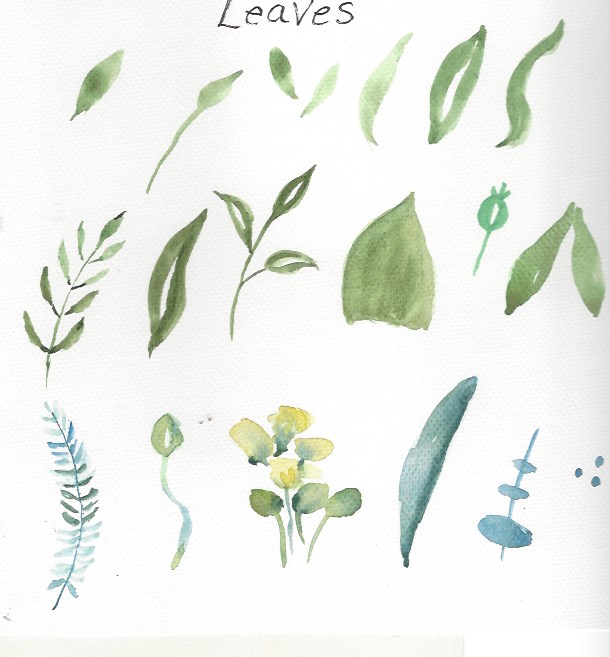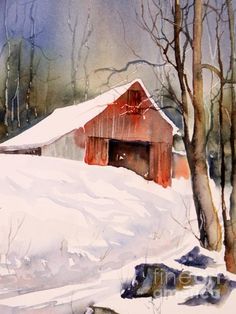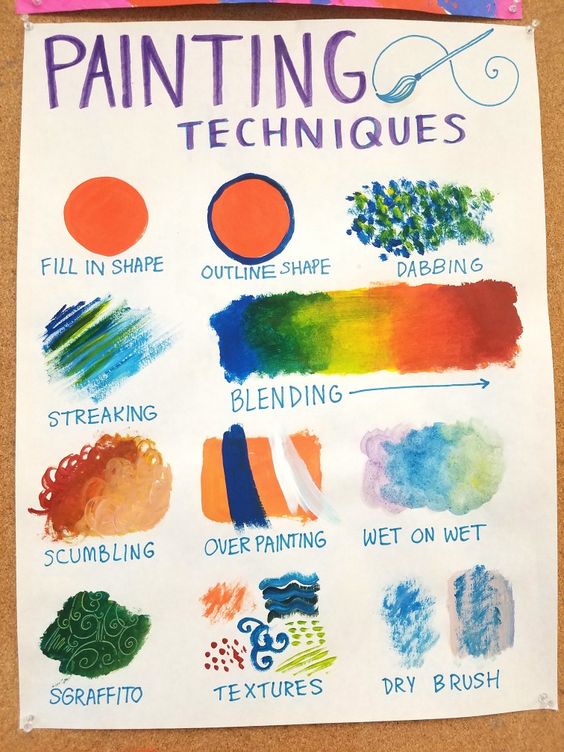Watercolor Painting lessons
Lessons below are presented from oldest project to the newest project taught at the Hendersonville Senior Citizen Center. The Second February Painting is the owl on a fence post.
Project #1 Valentine Card
ravinstudio.com for my art projects
Valentine cards are a great way to show someone other than your significant other that they are cared for. As you practice this rose, think of someone you might not have connected with for a while and mail it to them. I have several versions of a heart card. I started by just practicing on scrap paper creating a rose. Actually, I liked the practice sheet so much that I plan to frame it as a mini painting. I use watercolor cards, but you could just fold the watercolor paper you have using an old card as a size reference. Make a heart template by folding paper, drawing a half of a heart, and cutting that out. Lightly trace the heart on your card. Decide where you want two to four big roses and very lightly draw irregular roundish circles to remind yourself on the placement. Refer to some of the instruction sheets as you begin the rose, start with a darker pink or red in the center and build the petals outward. The fun part comes as you fill in around the rose. Make up flowers from your memory or refer to some of the reference sheets. Just remember, you don’t have to copy any design completely. You might also want to paint a rose on the envelope. I painted several versions of this heart with roses and I like the following card best.

The cards below were my first attempts.

Directions for Paining a Rose


Reference Sheet


This is my favorite for simplicity.
Project #2
Winter Barn Scene

Winter Barn
Life is like a box of chocolates. You never know what you’re going to get. This painting exercise is like that. You will be learning to paint wet-in-wet and also scraping into wet and damp paint. It may not turn out like anything you anticipated.
Go in with the attitude that it is a learning experience and maybe not a joyous painting to frame (or it might turn out absolutely gorgeous). Remember, when you paint a “dog”, you can always paint on the back of the painting.
Skill Builder 1: Mixing color on the paper instead of palette.
- Mix three or four separate puddles on your palette (milk consistency) Ultramarine blue, yellow, and dark green. Maybe purple or whatever is your favorite color.
- On practice paper wet a large area (shinny)
- Drop the colors from your puddles onto the water. Let some of the colors overlap and let some colors remain the dropped color. Visualize how this could be foliage. You may need to stir this a little with your brush. Do not stir it so much that you have one solid color.
- This technique is called “wet-in-wet”.
Project steps:
- Sun circle behind the barn..Wet an area behind the barn. Drop in some diluted yellow. If it is too bright, dab it with a Klenex
- Let this dry.
- Use your larger brush.Now wet the area behind the barn. Keep the water off of the barn roof. I like to cover the roof top with masking tape to get a good clean line. So you will have to use scissors to shape the pieces.. Hint. Once you pull your tape strip off the roll, tap it on your pants to get a little of the tacky off. Also, do not remove tape from any wet area of paint as it will tear your paper.
- Drop blue and yellow in the wet area. Drop a little of the dark green near the base of the water puddle. Have fun- drop in your favorite color. If any of the blue or yellow gets on the sun, gently blot with a Klenex.. You want this color to be a value 6 (fairly dark). It will need to have color for the scrapings to work. Also, watercolor dries lighter.
- While this is still damp (not shinny), scape up some tree trunks. Refer to the reference photo. Scape with a blunt but not sharp object like a credit card.. This step is easy to over do. Also, it takes practice (and patience) to get the effect you want. If you scratch when it is shinny, you get dark lines, If you let it dry so that it is damp, you get white lines. You want both.
- Gently remove the tape from the roof and leave the roof blank for now.
- Barn: Clean off your background puddles from your palette. Now mix a pinkish red, an orange and either a alizarin crimson (dark red) and a purple. Switch to your smaller brush. Go into one of your red puddles and pull it down to imitate barn planks. Vary the colors you pull down. Careful, this could look like a circus tent. So wet colors next to each other will blend together. You may need to even use the side of your large dry brush to blend the colors together. While this is still wet, scape lines down to suggest planks. Refer to the reference painting and paint in the barn windows and doors. You could just fill in with a dark color, but if you are going for a wow look, put is couple of colors and let them blend. Don’t stir that it becomes just one color.
- Snow: Mix up a light value of ultramarine blue and use just a touch of the diluted purple (two separate puddles). Refer to the reference to paint the hill shape. Leave some area white at the top of the hill. Put a light value of the blue from the road (interesting shape). You could just leave the roof white or add a touch of that snow shadow In some places.
- Trees: Mix a brown with a little of the ultramarine blue to gray it down. Paint a little yellow ochre down the left side of the tree trunk. While this is still wet add the darker brown to the right . Add the branches (minimally).
Note: Your painting is not going to look like the reference painting as this was a three hour painting that we are doing in an hour and a half. Plus there are some intermediate painting techniques. So learn some new techniques, enjoy the painting process and if it doesn’t turn out gorgeous don’t be disappointed with yourselves.
Scratching in wet paint Practice
Experiment with things you have around the house to scratch lines in damp paint. If the paint is shinny wet, you will get a dark line. Wait a few minutes and while the paper is damp, you can scratch white lines. Experiment in pulling down or scratching up. The edge of a credit card works well as a tool. I have included a set of winter scenes to inspire you.

Practice
Sometimes you may not want to attempt a painting. Just play with paint and mark making. No pressure.

Project #3 Snow Owl
Art is a process not a product. Relax and enjoy the process
The next project is a snow owl on a fence post. This is my painting. The background is a light value of Paynes Grey. My printer gives the background a brownish look.

Line Drawing: Print off the line drawing below. With a #2 pencil, put a heavy dark layer of the graphite on the back of the line drawing. Tape the drawing on your watercolor paper and trace the design.

Palette: Paynes Grey, Burnt Umber, yellow or Quinicrodrone Gold. Make a large puddle of Paynes Grey. The photo looks brown, but it is a very light value of grey. Also, you will need either white gouache or acrylic paint to splatter on for snow. Colored pencils: dark brown, blue, yellow ochre and also a dark grey or black.
Step One: Wet the sky area. Paint the sky area down to the snow. You are painting a flat area over the tree drawing. Let that dry. Add more grey to your grey puddle and paint the trees.
Step Two: Paint the road area with that same grey. It looks better if you are streaky and follows the flow of the road.
Step Three: Follow the reference in painting the owl. It is different values of grey and brown. This is a good time to use those pencils with sharpened to a good point
I mixed a little yellow with the brown to get a greenish gold at the top of the owl’s wing.
Step Four. Post and barb wire: With a dark value of brown, paint around the snow on the right side. Vary the value a little here, so that you get the feeling of bark. Use the brown colored pencil too. The snow on top of the post will not show up unless you put a hint of blue watercolor pencil at the top. Blend down with water. The barb wire is the dark black pencil or a Micron Black Marker. Be sure to put in the barbs. The weeds are best done with a rigger brush, but you could use a yellow ochre colored pencil.
Step Five Snow: Load up a toothbrush with either white gouache or acrylic paint. Use your thumb to splay the paint over the painting. It is good to practice this a little on scrap paper. If the paint is too thick, it doesn’t work well and if the paint is too watery , you could have big blobs of paint. If you get a blob, quickly blot with a paper towel or Klenex
Reference Photo

Reference Photo
